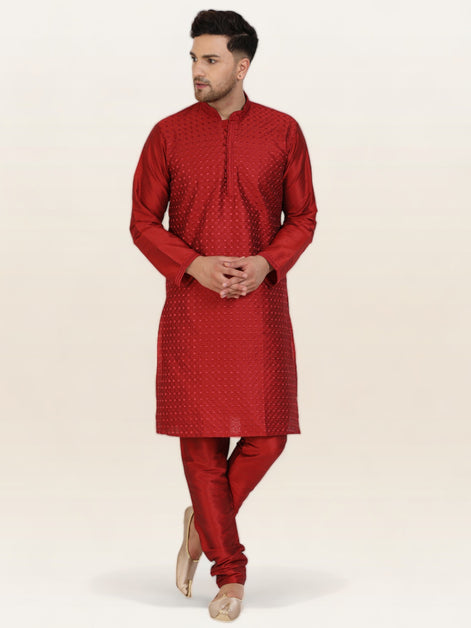Kurta For Wedding : Perfect Embrace Tradition with Elegance Day.
Posted by JITENDER SINGH

The Resplendent Elegance of Kurtas for Weddings: A Timeless Blend of Tradition and Style
In the kaleidoscope of wedding attire, the traditional kurta has emerged as a perennial favorite, captivating hearts with its timeless charm and versatility. Kurtas, with their rich cultural heritage and intricate designs, have become an integral part of wedding fashion, offering a perfect blend of tradition and contemporary style. This article delves into the resplendent world of kurtas for weddings, exploring their history, evolving styles, and the enchanting array of options available for both brides and grooms.
The Heritage of Wedding Kurtas:
The kurta, a traditional garment originating from South Asia, has a storied history that dates back centuries. Initially worn by men, kurtas have evolved over time to become a unisex garment, adorning both men and women on various occasions, with weddings being a prominent celebration. The craftsmanship and design of wedding kurtas are deeply rooted in cultural traditions, making them a symbol of elegance and refinement.
Men's Wedding Kurtas:
For grooms, the wedding kurta for men holds immense significance. Traditional Indian weddings often feature the groom donning an opulent kurta, complemented by intricate embroidery, luxurious fabrics, and exquisite detailing. The color palette for men's wedding kurtas spans a spectrum of vibrant hues, including regal reds, deep blues, and sophisticated creams, symbolizing prosperity and auspiciousness.
Women's Wedding Kurtas:
Women's wedding kurtas, commonly known as Anarkali suits or salwar kameez, are equally enchanting. These kurtas are characterized by their floor-length silhouette, flowy design, and elaborate embellishments. The color choices for women's wedding kurtas are vast, ranging from traditional reds and maroons to pastels and jewel tones, allowing brides to express their individual style.
Evolving Styles and Designs:
The world of wedding kurtas has witnessed a fascinating evolution, with contemporary designers seamlessly blending traditional aesthetics with modern sensibilities. The result is a diverse array of styles that cater to a wide range of preferences, ensuring that every bride and groom can find the perfect kurta to complement their wedding festivities.
Embroidery and Embellishments:
The allure of wedding kurtas lies in the intricate embroidery and embellishments that adorn them. Zardozi, resham, sequins, and mirror work are some of the traditional techniques that add a touch of opulence to these garments. Grooms often opt for heavily embroidered sherwanis or achkans, while brides may choose kurtas adorned with delicate threadwork or sequins for a more feminine appeal.
Silhouettes and Cuts:
Wedding kurtas come in a myriad of silhouettes and cuts, allowing for personalized choices based on body types and style preferences. Anarkali kurtas with their voluminous flares, straight-cut kurtas for a more contemporary look, and A-line kurtas for a balance between tradition and modernity are just a few examples of the diverse options available.
Color Palettes:
The color palette for wedding kurtas has expanded beyond traditional reds and golds. While these classic hues remain popular, contemporary brides and grooms are experimenting with unconventional colors such as emerald green, royal blue, and blush pink. The choice of color often reflects the couple's personality and the overall theme of the wedding.
Fusion Trends:
Fusion fashion has become a prominent trend in wedding kurtas. Designers are blending elements from different cultures, creating kurtas that seamlessly incorporate Western and Eastern influences. Fusion kurtas may feature contemporary cuts, unconventional fabrics, or a mix of traditional and modern embellishments.
Choosing the Perfect Wedding Kurta:
Consider the Wedding Theme:
The theme of the wedding plays a crucial role in choosing the perfect kurta. Traditional ceremonies may call for classic, heavily embroidered kurtas, while modern or destination weddings may provide the opportunity to explore contemporary or fusion styles.
Personal Style Preferences:
Individual style preferences should guide the selection of wedding kurtas. Whether opting for a traditional look with intricate embroidery kurta or a modern silhouette with minimal embellishments, the kurta should reflect the wearer's personality and taste.
Seasonal Considerations:
The season in which the wedding takes place influences the choice of fabric and style. Velvet and silk kurtas are suitable for winter weddings, while lightweight fabrics like georgette and chiffon are ideal for summer ceremonies.
Coordination with Partner's Attire:
Coordination between the bride's and groom's attire is a charming aspect of wedding fashion. Couples may choose complementary colors, coordinating embroidery patterns, or even matching elements in their kurtas for a harmonious look.
Conclusion:
The wedding kurta, with its rich history and evolving styles, stands as a testament to the enduring charm of traditional attire. Whether donned by the groom or the bride, these garments weave together cultural heritage and contemporary flair, creating a visual symphony of elegance during wedding celebrations. As couples embark on their journey into marital bliss, the choice of the perfect wedding kurta becomes a cherished part of the narrative, symbolizing not just fashion but the timeless union of love and tradition.
TAGS:




